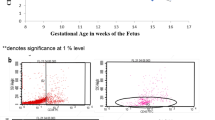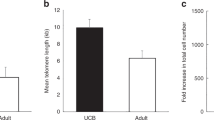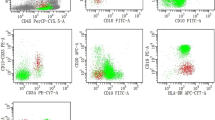Abstract
Umbilical cord blood (UCB) is an attractive potential alternative to bone marrow (BM) as a source of hematopoietic progenitor cells since the number of progenitors in UCB is similar or even greater than that in normal BM. It was the aim of the present study to analyze the degree of immaturity of UCB progenitor cells. UCB mononuclear (MNC) and/or CD34+ cells were tested for surface antigen phenotype, expression of cytokines receptor, effect of stem cell factor (SCF) on colony growth, resistance to mafosfamide and replating potential. We have found that 34.9 ± 3.4% and 77.9 ± 2.6% of UCB CD34+ cells did not express CD38 and CD45RA antigens, respectively, suggesting that UCB contains a high proportion of immature progenitor cells. By means of three-color analysis, the receptor for SCF was detected on the majority of the CD34+HLA-DR+ subpopulation; in fact, 81.8% ± 4.3% of CD34+HLA-DR+ cells were defined as SCFlow and 8.1 ± 1.5% as SCFhigh. Colony growth of MNC and CD34+ cells was enhanced by the addition of SCF to methylcellulose mixture, resulting in a statistically significant increase in CFU-GM and CFU-GEMM but not in BFU-E numbers. UCB progenitor cells showed a higher resistance to mafosfamide treatment, in comparison to BM; the addition of SCF to the culture medium resulted in a statistically significant increase in mafosfamide concentration required to inhibit 95% of colony growth (P ⩽ 0.05). Moreover, as shown by single colony transfer assays, the presence of SCF in primary cultures promoted a significantly higher replating potential for both untreated (42 ± 3.3% vs 21 ± 4.6%, P ⩽ 0.018) and mafosfamide-treated samples (62 ± 5.6% vs 44 ± 6.1%, P ⩽ 0.018). In conclusion, UCB is a source of progenitor cells with immature characteristics in terms of surface antigen expression, distribution of SCF receptor, resistance to mafosfamide and replating potential. Therefore, UCB progenitor cells represent an ideal candidate population for experimental programs involving gene transfer and ex vivo stem cell expansion.
This is a preview of subscription content, access via your institution
Access options
Subscribe to this journal
Receive 12 print issues and online access
$259.00 per year
only $21.58 per issue
Buy this article
- Purchase on Springer Link
- Instant access to full article PDF
Prices may be subject to local taxes which are calculated during checkout
Similar content being viewed by others
Author information
Authors and Affiliations
Rights and permissions
About this article
Cite this article
Almici, C., Carlo-Stella, C., Wagner, J. et al. Biologic and phenotypic analysis of early hematopoietic progenitor cells in umbilical cord blood. Leukemia 11, 2143–2149 (1997). https://doi.org/10.1038/sj.leu.2400871
Received:
Accepted:
Issue Date:
DOI: https://doi.org/10.1038/sj.leu.2400871
Keywords
This article is cited by
-
Circulating hematopoietic stem cell count is a valuable predictor of prematurity complications in preterm newborns
BMC Pediatrics (2012)
-
Characterization of CD34+ subsets derived from bone marrow, umbilical cord blood and mobilized peripheral blood after stem cell factor and interleukin 3 stimulation
Bone Marrow Transplantation (2000)



